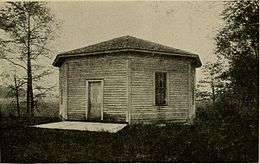Greased paper window
A greased paper window is a very inexpensive window made of paper coated in grease. The grease fills gaps between the paper fibers, reducing the amount of light lost to scattering.[1] Greased paper windows provide a diffuse light source, while blocking wind and preventing insects and other small animals from entering a structure.[1]

1919 photograph of an early-to-mid 19th century schoolhouse in Plain Township, Kosciusko County, Indiana, with a greased-paper window
Greased paper windows were often used by American pioneers of the early 1800s[2] and other itinerant peoples, in lieu of relatively expensive traditional glass windows.[1] Laura Ingalls Wilder recalled living in a home with a greased paper window in her 1937 children's novel, On the Banks of Plum Creek.[3]
See also
References
- Goodwin, Jane (July 1, 2014). "Little House Science: Greased Paper Windows". Steve Spangler Science. Retrieved 17 August 2016.
- "History of Spencer County". History of Warrick, Spencer and Perry Counties, Indiana, From the Earliest Time to the Present; Together with Interesting Biographical Sketches, Reminiscences, Notes, Etc. Goodspeed, Bros. & Co. 1885. p. 410. Retrieved 17 August 2016.
- Wilder, Laura Ingalls (October 20, 1937). On the Banks of Plum Creek. Harper Collins. p. 10. ISBN 9780064400046. Retrieved 17 August 2016.
There was a small greased-paper window beside the door. But the wall was so thick that the light from the window stayed near the window.
This article is issued from Wikipedia. The text is licensed under Creative Commons - Attribution - Sharealike. Additional terms may apply for the media files.